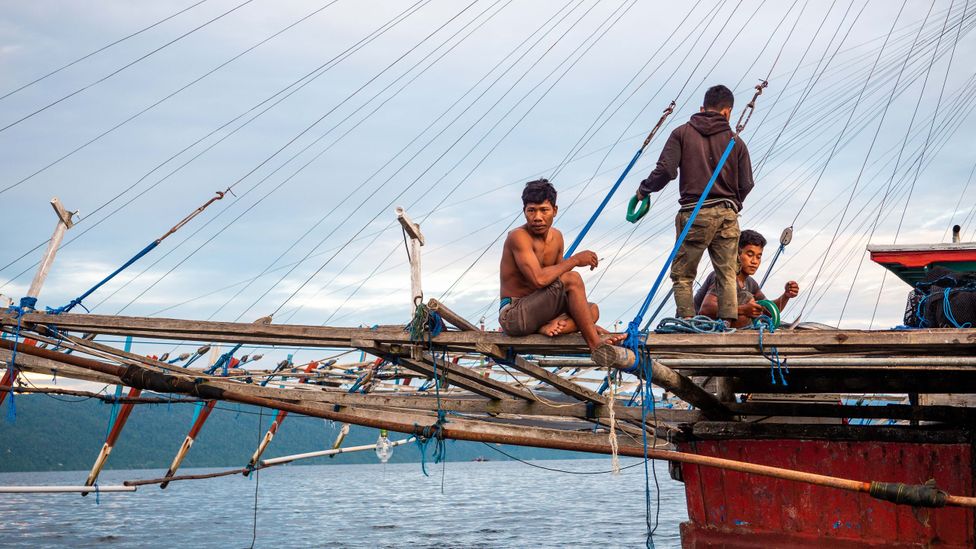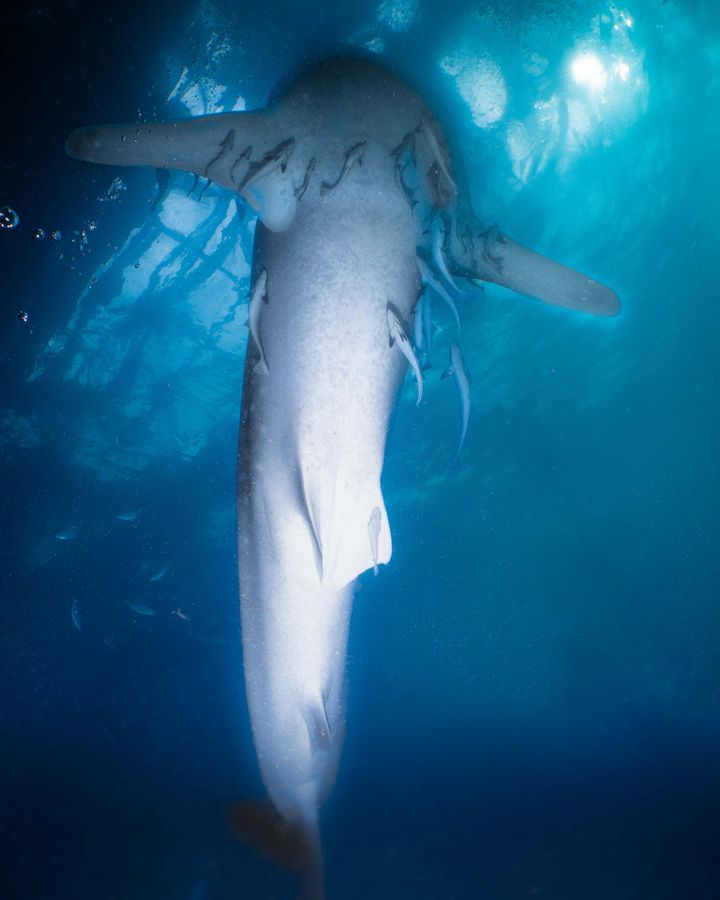In the remote area of Triton Bay in West Papua, a very special relationship has developed between the world's largest fish and generations of Bugis sea nomads.
My husband and I awoke to the voice of our guide, Indra, outside our bungalow. "Hey guys, we're on," he said. It was 04.30 and still pitch black out, but the sea was calm and the waning crescent moon was full of promise. A flock of Papuan hornbills soared overhead, their sound mimicking that of a helicopter flying by.
We were in Triton Bay in Indonesia's West Papua province to experience its incredible underwater landscape and photograph whale sharks. Triton Bay is one of very few places in the world where scuba diving with whale sharks is allowed, and the low visitor numbers and immense marine biodiversity make it one of the most unique and beautiful places to do it.
Safeguarded by virtue of its remoteness (Triton Bay is part of the Bird's Head Seascape, a 225,000 sq km global epicentre of marine biodiversity on West Papua's north-west tip), fewer than 500 people venture here each year. Those who do come will be awed by lush limestone peaks and white talcum-powder sands that plunge into a kaleidoscope of underwater coral gardens in nutrient dense, inky-blue seas.
We were staying at Triton Bay Divers, the first and only resort in Triton Bay: it caters to just 12 guests and organises dives with the giant sharks. We emerged from our beachfront bungalow and excitedly climbed into the waiting boat. Our Papuan captain signalled for us to turn off our torches so his night vision could take over: he needed it to safely navigate around the many islands and rocky limestone outcrops as we searched for the floating wooden fishing platforms, called bagans, where the whale sharks congregate.

The Bugis are a maritime people who spend most of their life at sea (Credit: Anita Verde)
The bagans are built by the Bugis, a maritime people who originated in southern Celebes (now known as the Indonesian island of Sulawesi), who are often referred to as "sea gypsies" or "sea nomads". The Bugis spend the majority of their lives at sea on their bagans, moving long distances in search of the richest fishing waters. Over generations they have developed an extraordinary relationship with the whale sharks who feed each morning beneath their nets, sucking succulent sardines through the tiny openings.
There are many places in the world where whale sharks congregate – such as Australia's Christmas Island and Ningaloo Reef, the Galapagos Islands, the waters off the Philippines' Donsol municipality and even the Red Sea – but unlike these places, where the majestic creatures are often fleeting visitors, whale sharks can be found year-round at Triton Bay. That's because where the Bugis and their bagans go, the whale sharks follow. Their reason? To get a free feed.
Diving with whale sharks here can't be prearranged: first you must find the Bugis and then ask their permission. Sometimes the Bugis are as close as 30 minutes to Triton Bay Divers Resort; however, on this occasion, it took us two hours to find them as the fish had migrated north towards the Kaimana coastline. As dawn approached, the soft morning light revealed a village of floating wooden structures in the waters. Their giant frames stretched out from all sides, supported by outrigger floats to keep them stable.
At night, rows of bright lights on the bagans illuminate the water below to attract fish, shrimp and plankton to the fishing nets. However, it was now 06:30 and the lights were dimmed and the nets raised. We approached one of the biggest bagans. As we docked by its side, Indra spoke with the operator, asking permission for us to dive beneath it. A Bugis fisherman named Aching immediately welcomed us on board.

Whale sharks feed each morning beneath the Bugis' nets, sucking small fish through the tiny openings (Credit: Peter Marshall)
He told us that all generations of his family have worked the bagan. In the past, Bugis fished just for themselves and to trade with local communities, but today the scale of industry is much larger, providing fish to local markets and further afield throughout the region. Aching had been fishing through the night and, with his nets now full, he was relaxing in the morning sun.
He gestured to us to peer beneath the platform into the sea. Immediately we glimpsed a colossal, whale shark: the world's biggest fish, as long a school bus. Its size was breath-taking. Aching told us there were actually three whale sharks below his bagan and he had left a net full of small sardines in the water for them to feed on.
Affectionately known by the Bugis as ikan bodo (stupid fish) because of their incredibly gentle and docile nature, whale sharks are revered by the Bugis as harbingers of good fortune. For generations, Aching said, his family has nurtured their relationship with the sharks in the hope that they will be reciprocated with a good catch. Each morning when he lifts his nets, he leaves one in the water for the whale sharks to feed from. "Just the small fish. They only like the small ones," he said.

To dive with whale sharks at Triton Bay, you must first find the Bugis and ask their permission (Credit: Anita Verde)
Interestingly, the belief that the whale sharks bring good fortune is supported by science. "Whale sharks, as well as dolphins, are believed to be good luck because their presence brings important fish such as anchovies, mackerel and tuna to the waters where they feed. They are an indicator of nutrient-dense water and ecosystem health," said Iqbal Herwata, elasmobranch and charismatic species conservation strategy manager at Konservasi Indonesia, Conservation International's implementing partner in-country. "Overall, the presence of whale sharks helps balance the food chain and ensures abundant food sources for their fellow ocean species and the Bugis fishermen.
"We love the whale sharks. I was taught that they will always bring our family good luck," Aching said.
That love has created an interesting migratory pattern. Data from Konservasi Indonesia indicates that while Triton Bay's whale sharks do display migratory patterns, many choose to spend most of their time in the area.
We love the whale sharks. I was taught that they will always bring our family good luck
One whale shark, called Dipsy, who was satellite tagged, spent most of its time over a 17-month period in Triton Bay, only briefly visiting the Aru and Kei Islands in the Maluku province of eastern Indonesia. Another, Junior, displayed a clear annual migration over 24 months, feeding in Triton Bay from November through to April, exploring the nearby Arafura Sea and the Timor Gap in May before returning back to Triton Bay in November. Because of this, the Bugis have over time developed unique relationships with the sharks. "It's a bit like they're catching up with old friends every time they pull up their nets," Indra said.
Before we got into the water with these gentle giants, Indra briefed us thoroughly. "Maintain a visual connection to the bagan," he said. "If you try to follow the whale sharks, it's easy to lose sight of the baganand become disorientated in the blue."

Triton Bay is part of the Bird's Head Seascape, a 225,000 sq km epicentre of marine biodiversity (Credit: Anita Verde)
Although there are no regulations in Indonesia as to how close you can get to a whale shark (unlike other countries), we were conscious to give the whale sharks the space and respect they need.
As we descended, we realised nothing had quite prepared us for the size of the creatures. A huge male rose from the deep, gently gliding past us and up to the surface, sucking the succulent sardines from the net's tiny openings into his cavernous mouth. Dwarfed, we cautiously moved closer to take a photo.
Suddenly a second huge male emerged from below, gently nudging us with his pectoral fin as he passed. We photographed his left pectoral fin, because the unique spot patterns there and behind the gills are the best way to identify it. After sending our photograph to Konservasi Indonesia as a contribution to their whale shark monitoring programme, we learned that he had first been sighted on 16 December 2021 and goes by the moniker WP-RT-0209.
Next, a third, slightly smaller male appeared. He curiously approached us front-on, with his enormous, fleshy mouth wide open. Peering inside to see rows of hundreds of tiny teeth, we held our ground, wondering if a collision might be imminent. But he gracefully passed by, looking deep into our eyes as he went. Below, a large pod of dolphins kept their distance, feeding on the odd sardine that drifted down from the nets.
The momentousness of being surrounded by three of the planet's largest yet most docile fish was difficult to comprehend. After three hours, with camera memory cards full and batteries exhausted, we were immensely grateful to the Bugis for sharing the opportunity to sit at the dining table of the biggest fish in the sea.




